
| KIT #: | AW144001 |
| PRICE: | $59.00 from Cooper's Models |
| DECALS: | One option |
| REVIEWER: | Scott Van Aken |
| NOTES: | Full resin kit |

| HISTORY |
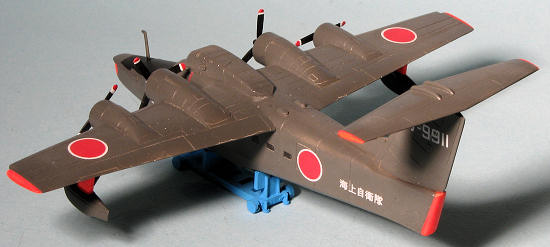 In 1960, Shin Meiwa demonstrated a prototype flying boat, the UF-XS, that featured a novel boundary layer control system to provide enhanced STOL performance. The company also built upon its wartime experience (as Kawanishi) to refine the Grumman Albatross hull that the aircraft was based on. The UX-FS was fitted with four engines, two of them the Albatross's normal Wright R-1820 radials with 1,065 kW (1,425 HP) each, plus two additional Pratt & Whitney R-1340 radials with 450 kW (600 HP) each. The aircraft's hull was extensively modified, and the Albatross's conventional tail was replaced by a tee tail. As a result of the success of what we now call a proof of concept aircraft, in 1966, the JMSDF awarded the company a contract to further develop these ideas into an ASW patrol aircraft. Two prototypes were built under the designation PS-X and flight tests began on October 5, 1967, leading to an order for production under the designation PS-1 in 1969.
In 1960, Shin Meiwa demonstrated a prototype flying boat, the UF-XS, that featured a novel boundary layer control system to provide enhanced STOL performance. The company also built upon its wartime experience (as Kawanishi) to refine the Grumman Albatross hull that the aircraft was based on. The UX-FS was fitted with four engines, two of them the Albatross's normal Wright R-1820 radials with 1,065 kW (1,425 HP) each, plus two additional Pratt & Whitney R-1340 radials with 450 kW (600 HP) each. The aircraft's hull was extensively modified, and the Albatross's conventional tail was replaced by a tee tail. As a result of the success of what we now call a proof of concept aircraft, in 1966, the JMSDF awarded the company a contract to further develop these ideas into an ASW patrol aircraft. Two prototypes were built under the designation PS-X and flight tests began on October 5, 1967, leading to an order for production under the designation PS-1 in 1969.
| THE KIT |
A&W contracted to Anigrand for this particular kit. This is not unusual as one finds Anigrand developed kits in the boxes of many resin model companies. Typical of their current work, the moldings are superbly done. I did find some minor glitches such as a build up of resin on one the wing roots and a chipped surface, but these will be easily overcome.
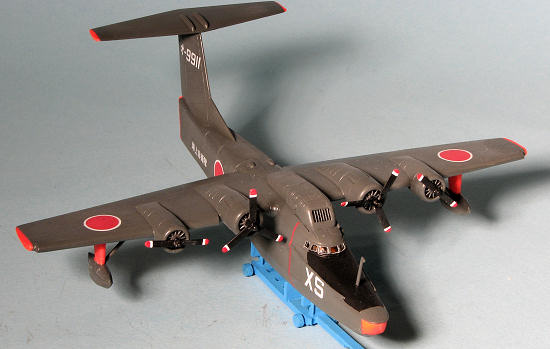 The fuselage halves are a bit warped out, but test fitting showed that this will not be an issue. There are large tabs and slots to allow the halves to be properly aligned when glued. I also fit the fin and stab, finding the fit there to be excellent. The engine cowlings are tabbed for proper alignment and while there is no distinction as to which are the 1820s and which are the 1340s, in this scale it makes little difference as they look the part.
The fuselage halves are a bit warped out, but test fitting showed that this will not be an issue. There are large tabs and slots to allow the halves to be properly aligned when glued. I also fit the fin and stab, finding the fit there to be excellent. The engine cowlings are tabbed for proper alignment and while there is no distinction as to which are the 1820s and which are the 1340s, in this scale it makes little difference as they look the part.
There are actually seats for the cockpit though one will see little through the thick, resin cockpit glass. The fuselage windows are molded in place so one will want to paint these black after the kit has been painted. Props and the wing float struts are in a separate bag to prevent loss and are well molded. The kit comes with a handling trolley. Mine had a wheel broken and thanks to the flimsy plastic bag in which the kit was packaged, had fallen through a hole punched in it by the fuselage.
Instructions are typical Anigrand with two CAD drawings of the completed kit showing where the parts are to be placed. A side view give paint and markings information. These planes were in dark grey with small day-glo patches on the nose, tail, wing tips, stabilizer tips and float struts. Unfortunately, no above view is provided to show the extent of the tip markings. I would recommend engine grey (FS 13081) for the overall shade. Decals are also typical Anigrand with two small identical sheets. These markings will fit well, though it seems setting solutions have no effect on them.
| CONSTRUCTION |
 This is not a complex kit, but does require some preparation. The first thing I did was to use my low speed motor tool and a small bit to remove the excess resin from the inside of one wing root. I kept grinding away until it fit flush in the fuselage opening. I still have to deal with the chipped wing root, but that will be taken care of once the wing is in place as it is on the top.
This is not a complex kit, but does require some preparation. The first thing I did was to use my low speed motor tool and a small bit to remove the excess resin from the inside of one wing root. I kept grinding away until it fit flush in the fuselage opening. I still have to deal with the chipped wing root, but that will be taken care of once the wing is in place as it is on the top.
 I then painted the cockpit black and the seats a light grey with orange seat faces. I mentioned that the fuselage halves were warped and here is a photo of that. As you can see, it looks like a lot, but by simply gluing in stages, the warp disappears. I also glued on the broken wheel from the beaching dolly.
I then painted the cockpit black and the seats a light grey with orange seat faces. I mentioned that the fuselage halves were warped and here is a photo of that. As you can see, it looks like a lot, but by simply gluing in stages, the warp disappears. I also glued on the broken wheel from the beaching dolly.
The engines had a bit of the back of the tab sanded down and the rear faces sanded flat. These were then test fit and then glued onto the wings. I caution the builder to be sure they are glued on exactly the way they were test fit. I found that the fit was better one way than the other, though it looks as if it shouldn't make any difference. I cannot stress eno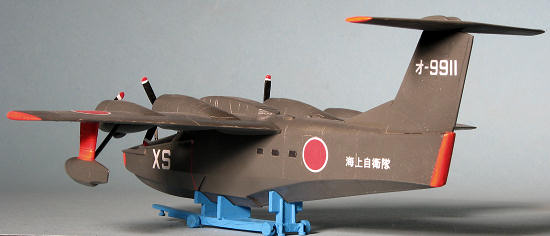 ugh to test fit each and every part prior to gluing as super glue is not forgiving and once glued, it is not going to come free.
ugh to test fit each and every part prior to gluing as super glue is not forgiving and once glued, it is not going to come free.
After the seats had dried, they were glued into each of the fuselage halves and then the halves were cemented together. As mentioned earlier, the best way I found was to glue this in sections. I started from the front and concentrated on getting the upper surface as well glued as possible, holding each area tightly together until the cement dried before moving on. This was repeated on the underside and it seemed to work very well. The entire fuselage seam was given a coating of superglue to fill in the rest of the seam and then sanded smooth.
I then installed the fin which took a bit of doing as it has to be sort of slid into place from the back, and glued on the wings. I took this opportunity to fill in the chips on the root with super glue and then sanded it smooth. With that done, the horizontal stab was glued in place. The upper hump on the fuselage was then attached. This had some gaps at the very back which needed some filler. The clear resin windscreen was attached using clear paint and the windows were masked.
| COLORS & MARKINGS |
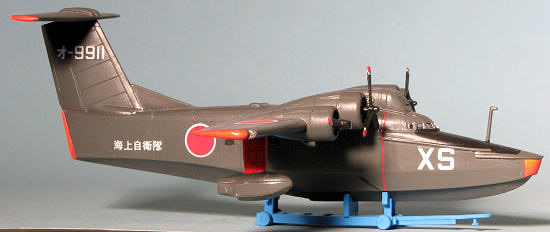 In preparation for painting, I wiped all the parts with lacquer thinner to try to remove any oils that may still be on it. Then it was primed with Tamiya white primer. This has the benefit of providing a white background for the daglo paint. For the daglo paint I used Humbrol gloss blaze. This is a rather translucent paint so needs to be applied in several layers. Once that was done, these areas were masked off using PMA's 3mm tape, and the remainder of the airframe was painted Engine Grey (FS 16081) using Testors enamels.
In preparation for painting, I wiped all the parts with lacquer thinner to try to remove any oils that may still be on it. Then it was primed with Tamiya white primer. This has the benefit of providing a white background for the daglo paint. For the daglo paint I used Humbrol gloss blaze. This is a rather translucent paint so needs to be applied in several layers. Once that was done, these areas were masked off using PMA's 3mm tape, and the remainder of the airframe was painted Engine Grey (FS 16081) using Testors enamels.
| FINAL CONSTRUCTION |
The next step was to add a few other bits. In this case, I installed the long nose sensor probe. Then, installing the struts into the floats first, I glued on each side float assembly. Fit is excellent. I then started applying the decals. These decals are nicely printed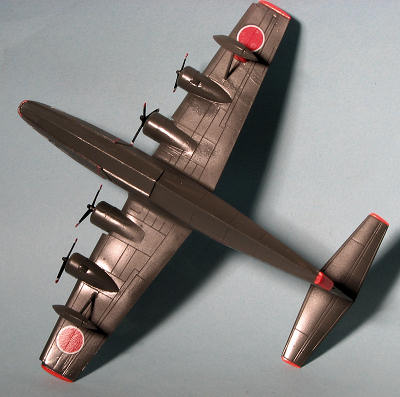 and while a tad transparent, work well on a solid background. These decals have a very short work time. They take a bit of time to get off the backing, but the glue quickly goes away so it is best to do these slowly. Setting solutions seem to have little if any affect on them.
and while a tad transparent, work well on a solid background. These decals have a very short work time. They take a bit of time to get off the backing, but the glue quickly goes away so it is best to do these slowly. Setting solutions seem to have little if any affect on them.
I found out that I had forgotten to paint on the anti-glare panel, so grabbing a bottle of Testors flat black and a brush, I painted that area as well as the props and the beaching cart. I ended up snapping off the misaligned prop and gluing it back in place before painting. Again using a brush, I painted the tips white then red. The beaching trolley was then painted Vallejo's Andrea Blue as a photo of this plane in a museum showed it with a light blue one. Wheels too as I guess those were solid steel.
Back at the body, I filled in the engine openings with matte black and then later carefully brushed the 'engines' with steel to provide some relief. The side windows were also painted black at this time with a fine brush. I then used the dark grey to mask any paint goofs. After all of that had dried, I inserted the props and glued them down. Then the airframe was given a coat of semi-matte as it just looked too glossy. True, the real plane is quite glossy, but for a model it looked a bit much. The masking was pulled from the windscreen and that was pretty much it.
| CONCLUSIONS |
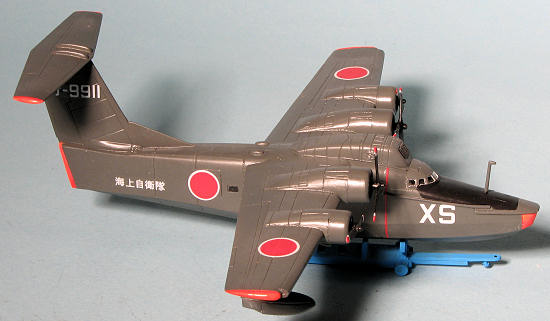 I have to say that I enjoyed building this one. The subject is interesting, the overall model is a decent size for 1/144 scale and the engineering and fit of the kit is really superb. I have to somewhat fault the decals for their lack of submission to setting solutions, though they can be pressed into engravings at bit with a fingernail. I also have to fault the instructions for not having a more complete markings guide that shows the upper and lower placement of paint and decals, including missing where the prop warning stripes. It would have been nice to have decals for the complex hatch pattern that was all over the airframe as I have to confess that few who buy this will want to put in the extensive effort to replicate that from white stripe decals. Even 1mm stripes will be far too wide and masking something like that is beyond most of us.
I have to say that I enjoyed building this one. The subject is interesting, the overall model is a decent size for 1/144 scale and the engineering and fit of the kit is really superb. I have to somewhat fault the decals for their lack of submission to setting solutions, though they can be pressed into engravings at bit with a fingernail. I also have to fault the instructions for not having a more complete markings guide that shows the upper and lower placement of paint and decals, including missing where the prop warning stripes. It would have been nice to have decals for the complex hatch pattern that was all over the airframe as I have to confess that few who buy this will want to put in the extensive effort to replicate that from white stripe decals. Even 1mm stripes will be far too wide and masking something like that is beyond most of us.
Still, it is one that I can quite easily recommend to those of you who like to build things a bit off the norm. .
| REFERENCES |
April 2012
ModelingMadness.com. All rights reserved. No reproduction in any form without express permission from the editor.
If you would like your product reviewed fairly and fairly quickly, please contact the editor or see other details in the
Back to the Review Index Page 2025